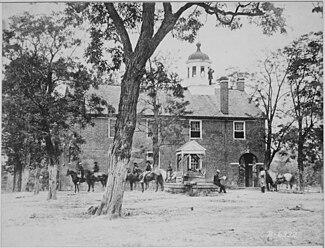
Back Batalla de Fairfax Court House (junio de 1861) Spanish Première bataille de Fairfax Court House French Battaglia di Fairfax Court House Italian Batalha de Fairfax Court House (junho de 1861) Portuguese Бой при Фэрфакс-Кортхаусе (1861) Russian Битва при Фейрфакс-Кортгауз Ukrainian 費爾費克斯首府前哨戰 Chinese
| Battle of Fairfax Court House | |||||||
|---|---|---|---|---|---|---|---|
| Part of American Civil War | |||||||
 Fairfax Court House, Virginia, a photograph by Mathew Brady now housed at the National Archives and Records Administration | |||||||
| |||||||
| Belligerents | |||||||
|
|
| ||||||
| Commanders and leaders | |||||||
|
Irvin McDowell David Hunter Charles Henry Tompkins |
Milledge Luke Bonham Richard S. Ewell (WIA) John Quincy Marr † William "Extra Billy" Smith | ||||||
| Strength | |||||||
| Between 50 and 86 | Between 40 and 80 engaged | ||||||
| Casualties and losses | |||||||
|
1 killed 4 wounded 3 captured |
1 killed 2 wounded 5 captured | ||||||
The Battle of Fairfax Court House was the first land engagement of the American Civil War with fatal casualties. On June 1, 1861, a Union scouting party clashed with the local militia in Fairfax, Virginia, resulting in the war's first deaths in action, and the first wounding of a field-grade officer.
The Union had sent a regular cavalry patrol under Lieutenant Charles H. Tompkins to estimate enemy numbers in the area. At Fairfax Court House, they surprised a small Confederate rifle company under Captain John Q. Marr, and took some prisoners. Marr rallied his unit, but was killed, and command was taken over by a civilian ex-governor of Virginia, William Smith, who forced the Union to retreat.
The engagement is judged to have been inconclusive. The Union did not gain the intelligence it was seeking, and had to delay its drive on Richmond, thus enabling the Confederates to build up their strength at Manassas in advance of the much-bigger battle there, the following month. Tompkins was criticized for exceeding his orders, although they had been somewhat imprecise.